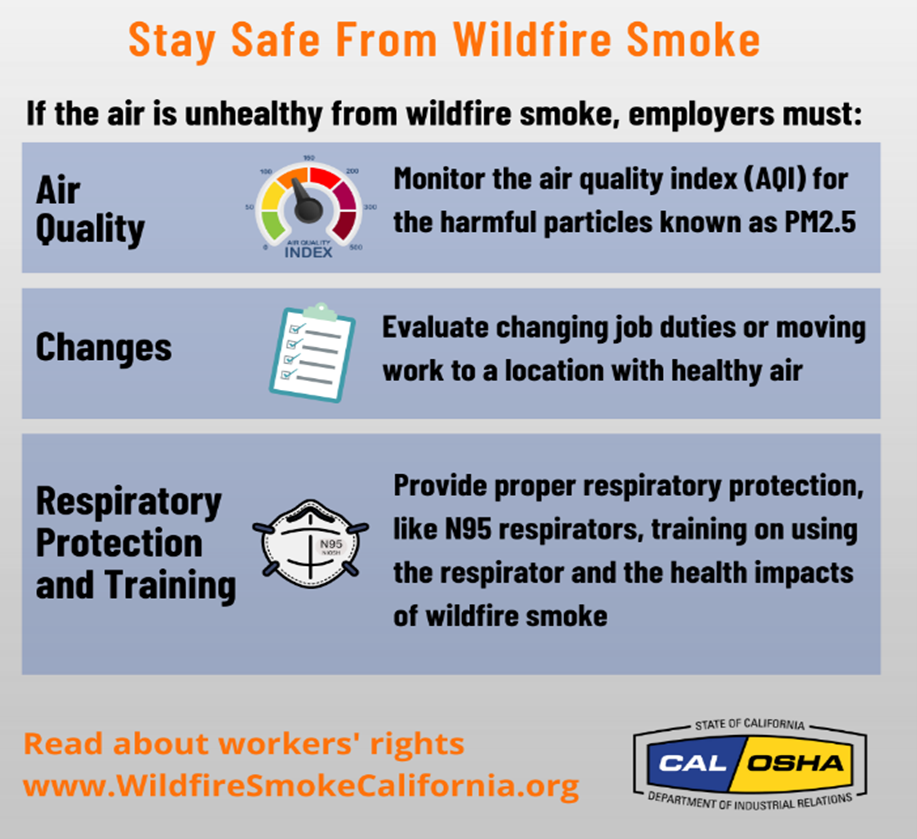January 8, 2025 | Pacific Palisades, CA — MedLegalNews.com — Cal/OSHA is reminding employers to take necessary steps to safeguard workers from unhealthy air caused by wildfire smoke. The Palisades Fire is currently impacting air quality in the Pacific Palisades area. Updates on the fire’s status, road closures, and evacuation orders can be found on the California Department of Forestry and Fire Protection (Cal Fire) website. Wildfire Smoke Alert
Current Impact of Wildfire Smoke
At present, the wildfire smoke is impacting the Pacific Palisades area in Los Angeles County. However, it is crucial to note that the smoke could eventually spread to nearby cities, posing a broader risk to air quality and worker health. Wildfire Smoke Alert
Cal/OSHA’s Protection from Wildfire Smoke Standard
Under Cal/OSHA’s Protection from Wildfire Smoke standard, employers are required to protect workers from the adverse effects of unhealthy air due to wildfire smoke. Employers must monitor air quality, adjust work practices accordingly, and provide N-95 respirators for voluntary use. Additionally, the standard outlines specific training requirements that employers must adhere to in order to ensure worker safety. Wildfire Smoke Alert
Key Requirements for Employers
- Monitoring Air Quality: Employers must monitor the Air Quality Index (AQI) for PM2.5 both before and during the work shift when wildfire smoke is present.
- If the AQI for PM2.5 exceeds 150, employers are required to provide respirators to all workers and encourage their use.
- If the AQI for PM2.5 surpasses 500, the use of respirators becomes mandatory.
- Resources and Training: Full details of the standard, along with resources in both English and Spanish, are available at www.WildfireSmokeCalifornia.org and www.HumodeIncendios.org.

Tracking Air Quality
Employers can track air quality through websites such as the U.S. EPA’s AirNow or local air quality management district websites. Additionally, employers may use their own instruments to measure PM2.5 levels at worksites, as per Cal/OSHA’s requirements.
Worker Rights in Evacuation Zones
It is important for employers to understand that in California, it is illegal to retaliate against workers who refuse to work in unsafe conditions, including those in evacuation zones. For more information, refer to the fact sheet on Worker Safety Wildfire Smoke and Evacuation Zones.

For real-time air quality updates and wildfire safety resources, visit the California Department of Forestry and Fire Protection.
Stay updated on Cal OSHA enforcement and worker safety developments — subscribe to MedLegalNews.com for the latest regulatory and legal insights.
🔗 Read More from MedLegalNews.com:
- Cal/OSHA Cites Safeway for Exposing Workers to Hazards at Largest Warehouse in Tracy
- CA Doctor to Plead Guilty to Conspiring with Attorney to Defraud SIBTF of $3 Million
- Updated Pharmaceutical Fee Schedule Effective July 1, 2025, Adopted by CA DWC
- Veto of Senate Bill 1299: A Setback for Farmworker Protections in California’s Workers’ Compensation System
- DWC Posts Reminder for Submission of Annual Report of Inventory for Claims Reported During Calendar Year 2024
FAQs: Employer Responsibilities and Worker Rights Under Cal OSHA’s Wildfire Smoke Protection Rule
What wildfire smoke protection measures must employers take?
Employers are required to monitor air quality and provide N-95 respirators when wildfire smoke protection levels fall below Cal OSHA safety standards.
When does Cal OSHA mandate respirator use for wildfire smoke protection?
Cal OSHA requires respirators when the AQI for PM2.5 exceeds 150 and mandates their use when it surpasses 500 to ensure wildfire smoke protection for workers.
How can employers track air quality for wildfire smoke protection?
Employers can use official sites such as AirNow or local air district tools to monitor AQI and maintain compliance with wildfire smoke protection standards.
What rights do workers have under Cal OSHA’s wildfire smoke protection rule?
Workers may refuse unsafe work due to poor air quality without fear of retaliation under Cal OSHA’s wildfire smoke protection and evacuation zone rules.
